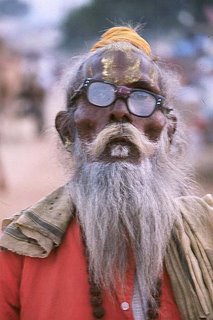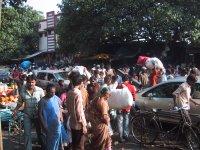 Just crossing the street in India can be a challenging activity, especially when you're not familiar with its pace and etiquette. It can have a daunting look, with its constant flow of rickshaws, whole families piled on top of scooters, camel drawn carts, buses bulging at the seems, and of course a tranquil Hindu cow meandering through the traffic. Just when you think you know what to expect, a nine-year-old boy manages to drive his herd of forty goats straight down one of the busiest streets of the center of Calcutta, changing everything. I don't know what academic value there is to it, but I wanted to dedicate some space to a description of some of the more interesting ways of getting around in India.
Just crossing the street in India can be a challenging activity, especially when you're not familiar with its pace and etiquette. It can have a daunting look, with its constant flow of rickshaws, whole families piled on top of scooters, camel drawn carts, buses bulging at the seems, and of course a tranquil Hindu cow meandering through the traffic. Just when you think you know what to expect, a nine-year-old boy manages to drive his herd of forty goats straight down one of the busiest streets of the center of Calcutta, changing everything. I don't know what academic value there is to it, but I wanted to dedicate some space to a description of some of the more interesting ways of getting around in India.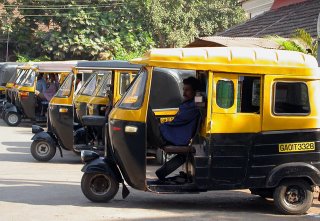 e constant high pitched honk. The horn is used in India as part of a complex alert system that allows other drivers to know where everybody is at all times without anyone having to turn their head - or maybe they just really like it. When you get inside see if you can tell how the driver operates the brakes, the gas and changes gears all at once. A thirty minute ride should be about forty rupees (a little less than an American dollar).
e constant high pitched honk. The horn is used in India as part of a complex alert system that allows other drivers to know where everybody is at all times without anyone having to turn their head - or maybe they just really like it. When you get inside see if you can tell how the driver operates the brakes, the gas and changes gears all at once. A thirty minute ride should be about forty rupees (a little less than an American dollar).CYCLE-RICKSHAW A cycle-rickshaw is also an option in most of India, although it can be a slightly uncomfortable thing when you find yourself behind an elderly man straining to peddle you through the choking smog of India's streets. Almost all cycle-rickshaws are not owned by their drivers, but are rented out by the day from a larger company. They offer a great pace to tour an Indian city by, and I have sometimes arranged to stick with the same driver for a whole day of sight-seeing. On one occasion I had a driver let me take him for a spin and it was hard going, with only one gear. I can only imagine what it is like when you're hauling a whole family around back there, as they often are.
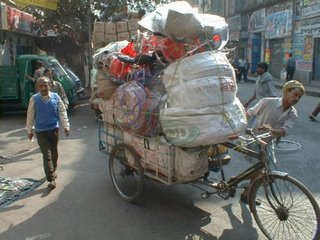
Last in the rickshaw family is the hand rickshaw, or jin riki sha in Japanese, literally meaning "man-powered vehicle". It was designed in about 1870 in Japan, and it soon spread throughout the colonial networks which were in Asia at that time. It is a light wooden cart with large diameter wheels, generally also in wood, drawn by a man running between two long shafts that project in front. Insofar as it required only one man to pull another, it was at the time an "advance" over previously available vehicles.
Today they are banned almost everywhere in the world, and the last sizable fleet
of hand rickshaws can only be found in Calcutta, where the rickshaw wallah union has resisted prohibition. In 1992, it was estimated that over 30,000 rickshaws were operating in the city, all but 6,000 of them illegally, or lacking a license. The large majority of rickshaw wallahs rent their rickshaws for a few hundred rupees per shift, so if they seem desperate for business it is because if they don't get enough customers it comes out of their pocket.
I saw hand-rickshaws when I was in Calcutta when the monsoon had first struck the city. No one was happier to see the rains come than them. Within days the street are flooded waist deep and hand-rickshaws become the only means of transportation capable of navigating much of the city.
BUS
You could take a bus, if you're crazy. Perhaps the most comfortable area inside is the small compartment for the driver which has seating for around five. The only drawback is your bird's-eye view of the near misses and potential head on collisions. And of course the blearing Indian duets that are blasted over the radio in an attempt to keep the driver awake.
Train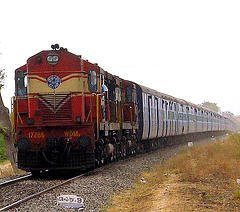 Indian trains are in a category of their own when it comes to travel in India. The Indian Railway System is one of the largest and busiest rail networks in the world, and it is also the world's largest commercial employer, with more than 1.6 million employees. It manages to transport over six billion passengers a year - that's roughly the equivalent of the entire population of the planet. Then there is the almost 750 million tons of freight moved along it tracks a year. It's pretty amazing that it call comes together and for the most part works.
Indian trains are in a category of their own when it comes to travel in India. The Indian Railway System is one of the largest and busiest rail networks in the world, and it is also the world's largest commercial employer, with more than 1.6 million employees. It manages to transport over six billion passengers a year - that's roughly the equivalent of the entire population of the planet. Then there is the almost 750 million tons of freight moved along it tracks a year. It's pretty amazing that it call comes together and for the most part works.

 There is nothing quite like sitting by the open door of an Indian sleeper train and watching the countryside roll by. For three or four dollars you can take a train from one side of India to the other. It may take a few days to get there, but you may find that the trip there is as much fun as wherever it is you are going. Food and beverages are available at every stop, you just have to listen for the call of the different vendors who call out their trade along the tracks when you pull into the station. When you come to complete stop they'll streaming down the eisle and coming up to the windows. I recomend the tiny packages of biscuits, the somosas, and if you're feeling crazy the fresh fruit.
There is nothing quite like sitting by the open door of an Indian sleeper train and watching the countryside roll by. For three or four dollars you can take a train from one side of India to the other. It may take a few days to get there, but you may find that the trip there is as much fun as wherever it is you are going. Food and beverages are available at every stop, you just have to listen for the call of the different vendors who call out their trade along the tracks when you pull into the station. When you come to complete stop they'll streaming down the eisle and coming up to the windows. I recomend the tiny packages of biscuits, the somosas, and if you're feeling crazy the fresh fruit.
When it's time to sleep the back of the bottom bench smartly folds up to form the middle berth, and what was your little living room suddenly becomes sleeping for eight , although that's just an estimate. Depending on the diligence of the TTE (traveling ticket inspector) you could have any number of people sleeping in your compartment during the night. I recommend the upper berths as you can turn in early or sleep in late at your leisure. There are three little fans that operate from a switch down below. Bring a little blanket to use as a sheet or to cover you if it's somewhere cold. Don't worry, the gentle sway of the train, the long fading whistle, and the click-clack of the wheels clamoring down the track, conspire to form a rhythmic symphony that lulls you into a dreamy sleep. Don't be surprised when a group of traveling musicians wake you from your slumber - when you pay them they'll go away. In the morning you wake to the sing-song voice of the chai wallahs making their rounds, "Chai, Chai, Chai....". The train pulls into a tiny little village station and you catch a glimpse of the India between its cities; a place where the pace has changed little for thousands of years. Village women dressed in saris of every color and laden with jewelry from head to toe scramble on with their goods to bring to the market in the next village. There is never a dull moment.
The train is also the place to experience the remarkable generosity of Indian people. More than once I have had the happy chance to share my compartment with an Indian family that takes out their little tin lunch-box containing the food for their journey, and insists that I get my share and give everything a try. It is a great opportunity to get your questions answered about Indian history, the caste system, arranged marriages, religion, philosophy or anything else you are curious about. Don't worry, they'll have plenty of questions for you too.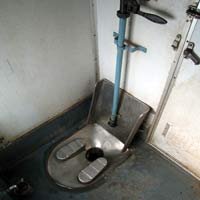
This is the toilet on the train, don't use it when you're at the station because it's just a hole that leads down to the tracks below.
Getting your ticket
Getting a ticket for an Indian train is something that takes some getting used to. To prevent being cut, Indians que up without an inch to spare between them - don't be surprised if someone has a little lean on you or drapes their arm over your shoulder. Personal space has an entirely different definition here. At the front of the line there is a bottleneck of Indians trying get a hand into the tiny hole through which you are supposed to speak to the reservationist. If you're lucky enough to make it up to the reservation's he will give you about twelve seconds to make sense to him, if you don't it's on to the next person begging for his attention. In some stations there is a separate window for "freedom fighters" and "foreign tourists," so if you fit into either of those categories you could save some time, unless you are uncomfortable accepting special treatment when there are so many other who have to wait. There are cars with a number of different classes in an Indian train. What was called "3rd class unreserved" when I was in India last, is now euphemistically called "general seating". It consists of wooden seats in rows. General seating cars are always the first and last on an Indian train and it can be a real battle just to get on board. Once inside it is perfectly possible for there to be absolutely no place for you to sit or lay down even if it is an overnight train. In my experience once you make it clear that you intend to stay, someone finds some space for you somewhere. Once settled people are remarkably tolerant of one another considering the conditions they are forced to share and if it's good enough for the mahatma, who always rode third class, it's good enough for me.
There are cars with a number of different classes in an Indian train. What was called "3rd class unreserved" when I was in India last, is now euphemistically called "general seating". It consists of wooden seats in rows. General seating cars are always the first and last on an Indian train and it can be a real battle just to get on board. Once inside it is perfectly possible for there to be absolutely no place for you to sit or lay down even if it is an overnight train. In my experience once you make it clear that you intend to stay, someone finds some space for you somewhere. Once settled people are remarkably tolerant of one another considering the conditions they are forced to share and if it's good enough for the mahatma, who always rode third class, it's good enough for me.



